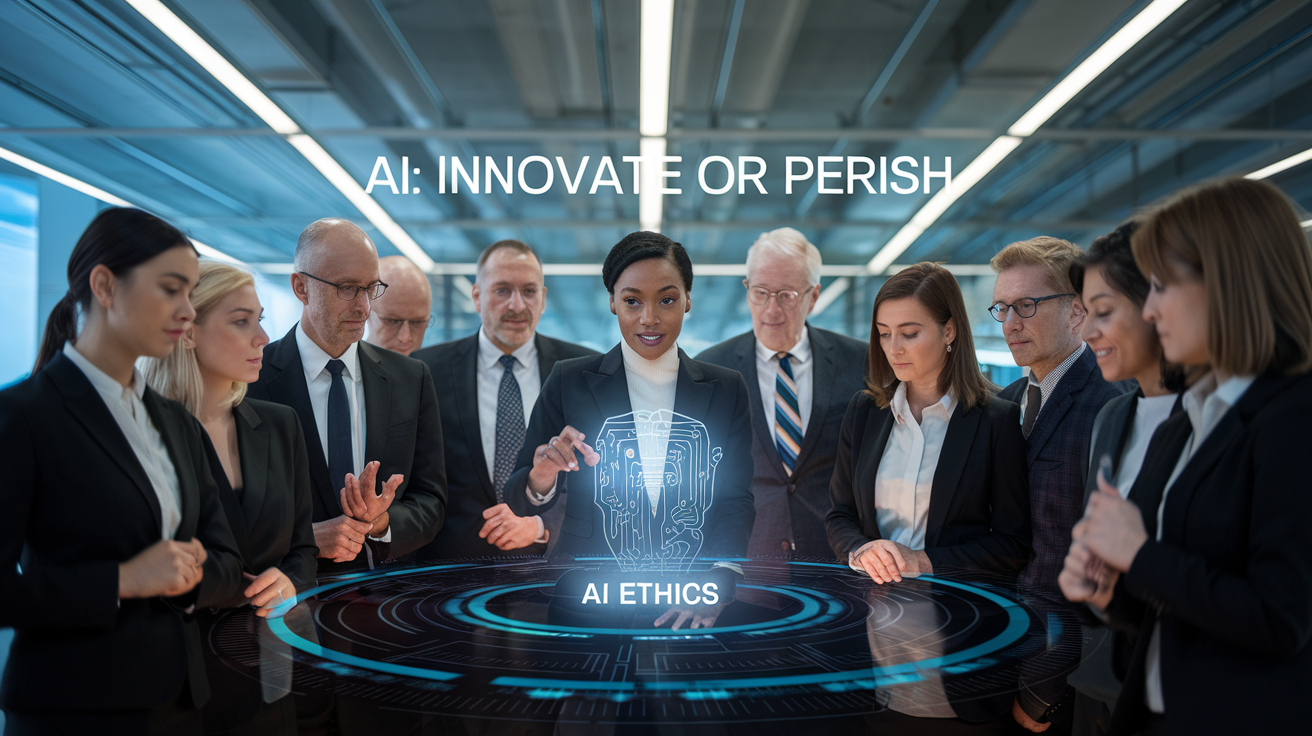In today’s rapidly evolving business landscape, ignoring AI is tantamount to signing your company’s death warrant. As I’ve witnessed firsthand, the transformative power of artificial intelligence is reshaping industries at breakneck speed. But here’s the kicker: it’s not just about adopting AI; it’s about doing it ethically and sustainably.
You might be thinking, “Sure, AI sounds great, but what about the risks?” I can start ignoring AI. 🤔 I get it. The regulatory landscape is shifting, transparency concerns are mounting, and the environmental impact of AI is under scrutiny. It’s enough to make any business leader hesitate. But here’s the truth: inaction is the biggest risk of all. In this blog post, I’ll guide you through the critical aspects of ethical AI implementation, from navigating regulations to leveraging cloud infrastructure, ensuring you’re not just keeping up, but staying ahead of the curve.
The Critical Importance of Ethical AI in Business

A. Aligning AI with core values and legal standards
As I delve into the critical importance of ethical AI in business, I can’t stress enough how crucial it is to align AI systems with our core values and legal standards. In my experience, this alignment forms the foundation of responsible AI integration. I’ve found that establishing an AI Ethics Committee, comprising diverse experts, is an excellent first step. This committee can help develop ethical AI policies that resonate with our organization’s principles.
When it comes to legal compliance, I always ensure our AI systems adhere to regulations like GDPR and the Algorithmic Accountability Act. It’s not just about avoiding penalties; it’s about building trust with our stakeholders. I’ve learned that transparency in our AI processes goes a long way in maintaining this trust.
B. Addressing challenges in AI ethics implementation: Ignore Ai at your peril
Implementing ethical AI isn’t without its hurdles. I’ve encountered several challenges, but I’ve also discovered effective ways to address them:
- Employee education
- Ethical design practices
- Continuous monitoring and evaluation
- Fostering a culture of ethical AI innovation
I’ve found that regular training on ethical principles and decision-making frameworks is crucial. It’s not just about the technical aspects; it’s about nurturing a mindset that prioritizes ethics in every AI-related decision we make.
C. Developing a comprehensive AI risk taxonomy
In my journey of implementing ethical AI, I’ve realized the importance of developing a comprehensive AI risk taxonomy. This structured approach helps us identify, assess, and mitigate potential risks associated with AI deployment. Here’s a simplified version of the taxonomy I use:
| Risk Category | Description | Mitigation Strategy |
|---|---|---|
| Algorithmic Bias | Unfair or discriminatory outcomes | Regular audits, diverse datasets |
| Data Privacy | Mishandling of sensitive information | Robust security measures, transparent policies |
| Transparency Issues | Lack of explainability in AI decisions | Implementing interpretable AI models |
| Job Displacement | Workforce concerns due to AI adoption | Clear communication, skill development programs |
By systematically addressing these risks, I ensure that our AI implementation remains ethical and aligned with our business objectives.
As we move forward, it’s crucial to consider how ethical AI practices intersect with corporate sustainability. In the next section, “AI’s Dual Impact on Corporate Sustainability,” I’ll explore how responsible AI implementation can contribute to long-term business success while addressing broader societal and environmental concerns.
AI’s Dual Impact on Corporate Sustainability

Now that we’ve explored the critical importance of ethical AI in business, I want to delve into AI’s dual impact on corporate sustainability. This fascinating intersection presents both opportunities and challenges for companies like ours.
A. Enhancing operational efficiencies and reducing emissions
I’ve found that AI can significantly boost our sustainability efforts while driving profitability. For instance, I’ve seen AI-powered recommendation engines, like Ikea’s, aligning product suggestions with consumer sustainability preferences. This approach not only enhances customer engagement but also promotes eco-friendly choices.
Here’s a quick overview of how AI can improve sustainability outcomes:
| AI Application | Sustainability Benefit |
|---|---|
| Customer engagement | Clarifies product sustainability |
| Financial tracking | Rewards emission reduction efforts |
| Risk assessment | Enhances resilience against environmental risks |
| Digital twins | Optimizes energy efficiency in operations |
B. Mitigating increased energy consumption from AI deployment
While AI offers tremendous benefits, I must acknowledge its potential to increase energy consumption. As we experiment more with AI, particularly generative AI, our IT-related carbon emissions are projected to surge. To address this, I’m advocating for close collaboration between our technology and sustainability teams.
Key principles I’m implementing include:
- Recognizing IT’s significant carbon footprint
- Prioritizing decarbonization in cloud services
- Fostering sustainable AI practices from the outset
C. Implementing sustainable AI use policies and tracking
To ensure our AI initiatives align with our sustainability goals, I’m implementing robust policies and tracking mechanisms. I’ve learned that open-source tools are emerging to evaluate the carbon emissions of AI models, considering factors like:
- Training duration
- Energy efficiency of GPUs
- Data center location
- Potential offsets by service providers
However, I’m aware of the challenges these tools face, such as data accuracy and limited scope of analysis. That’s why I’m pushing for a more comprehensive approach to measure AI’s sustainability impacts, including compute operations, electricity usage, carbon footprint, and water consumption.
As we move forward, I’m keeping a close eye on the evolving AI regulatory landscape. This will be crucial in navigating the complex intersection of AI, sustainability, and compliance.
Navigating the Evolving AI Regulatory Landscape

Now that we’ve explored AI’s dual impact on corporate sustainability, it’s crucial to navigate the evolving AI regulatory landscape. As businesses increasingly adopt AI technologies, understanding and complying with existing and emerging regulations is paramount for responsible innovation.
A. Existing laws applicable to AI
I’ve observed that current AI compliance largely relies on existing legal frameworks. In the United States, for instance, we’re seeing a patchwork of regulations:
- The Algorithmic Accountability Act: Aims to increase transparency in AI decision-making
- Local Law 144 in New York City: Addresses AI use in employment decisions
Internationally, I’ve noted significant developments:
| Country/Region | Key Regulation |
|---|---|
| European Union | AI Act (effective August 1, 2024) |
| China | Strict generative AI regulations |
| Japan | Human-centric AI principles |
B. Emerging AI-specific regulations
I’m seeing a rapid evolution in AI-specific regulations globally. Some noteworthy developments include:
- EU AI Act: Categorizes AI systems by risk levels
- U.S. state-level regulations: Varying approaches to AI governance
- ISO/IEC 42001 standard: Guides responsible AI governance
- Council of Europe’s AI Convention: Emphasizes human rights in AI use
In the U.S., I’m particularly interested in the Biden administration’s Executive Order 14110, which outlines a proactive approach to responsible AI use, focusing on:
- Risk mitigation
- Worker protection
- Data privacy
- International collaboration
C. Balancing innovation with responsible AI practices
I believe that striking a balance between innovation and responsible AI practices is crucial. Here’s how I suggest businesses approach this challenge:
- Establish clear AI policies aligned with regulatory requirements
- Implement robust risk management strategies
- Promote AI literacy within the organization
- Prioritize data security and privacy
- Maintain transparent monitoring processes
It’s important to note that non-compliance can lead to severe consequences, including financial penalties and reputational damage. To mitigate these risks, I recommend leveraging AI compliance software tools that can:
- Automate compliance workflows
- Monitor regulatory changes in real-time
- Assess risks effectively
- Provide transparent reporting
As we move forward, I believe that navigating this complex regulatory landscape will be essential for businesses looking to leverage AI ethically and effectively. With this in mind, next, we’ll explore how leveraging cloud infrastructure can support ethical AI development while ensuring compliance with these evolving regulations.
Leveraging Cloud Infrastructure for Ethical AI Development

Now that we’ve navigated the evolving AI regulatory landscape, it’s crucial to explore how we can leverage cloud infrastructure for ethical AI development. I’ve found that this approach not only enhances our AI initiatives but also aligns them with our broader sustainability goals.
A. Aligning AI initiatives with ESG goals
In my experience, integrating AI with Environmental, Social, and Governance (ESG) objectives is essential for responsible business practices. I’ve discovered that cloud-based AI development offers a unique opportunity to achieve this alignment. Here’s how I approach it:
- Define clear AI usage goals that complement our ESG strategy
- Ensure data security to prevent misuse and maintain stakeholder trust
- Implement secure AI pipelines to protect against tampering
- Deploy applications on validated, secure cloud systems
By following these steps, I’ve been able to create a robust framework that supports both our AI initiatives and sustainability efforts.
B. Implementing frameworks for bias detection and compliance
To maintain ethical AI practices, I’ve found it crucial to implement comprehensive frameworks for bias detection and regulatory compliance. Here’s a table outlining the key components I use:
| Component | Purpose | Implementation |
|---|---|---|
| Fairness Indicators | Identify bias in data and models | Use during data collection and model evaluation |
| Explainable AI | Ensure transparency in decision-making | Employ Vertex Explainable AI |
| Data Lineage Tracking | Monitor data movement and transformation | Establish clear tracking mechanisms |
| Accountability Measures | Maintain responsible AI practices | Implement logging and error reporting |
| Differential Privacy | Protect individual data points | Apply during model training |
By incorporating these elements, I’ve been able to create AI systems that are not only powerful but also ethical and compliant with evolving regulations.
C. Addressing challenges in measuring AI’s sustainability impact
Measuring the sustainability impact of AI has been one of the most challenging aspects I’ve encountered. To address this, I’ve developed a strategic approach:
- Collaborate with business leaders, data scientists, and IT personnel
- Conduct regular testing of AI models for unintended consequences
- Establish a continuous feedback loop in the AI model lifecycle
- Actively work to mitigate biases and potential harmful effects
- Tailor information about AI operations for different stakeholders
By implementing these strategies, I’ve been able to better quantify and manage the sustainability impact of our AI initiatives.
As we move forward, ensuring AI transparency and accountability becomes paramount. In the next section, I’ll delve into how we can further enhance these aspects to build trust and maintain ethical AI practices.
Ensuring AI Transparency and Accountability

Now that we’ve explored how to leverage cloud infrastructure for ethical AI development, let’s dive into ensuring AI transparency and accountability. This is a crucial aspect of responsible AI implementation that I can’t stress enough.
A. Training employees in responsible AI use
I believe that educating our workforce is the first step towards achieving AI transparency and accountability. Here’s how I approach this:
- Develop comprehensive training programs
- Focus on ethical decision-making
- Emphasize the importance of data privacy
- Encourage continuous learning
By investing in employee education, I’ve seen a significant improvement in the responsible use of AI across organizations.
B. Implementing comprehensive governance structures
In my experience, robust governance is key to maintaining accountability. Here’s a breakdown of the essential components:
| Governance Component | Purpose |
|---|---|
| Clear policies | Define ethical guidelines and acceptable AI use |
| Oversight committees | Monitor AI development and deployment |
| Regular audits | Ensure compliance with ethical standards |
| Feedback mechanisms | Allow stakeholders to voice concerns |
I’ve found that implementing these structures helps create a culture of responsibility and transparency.
C. Monitoring and adapting AI training datasets for fairness
I can’t overemphasize the importance of fair and unbiased AI systems. To achieve this, I focus on:
- Regularly reviewing and updating training datasets
- Implementing diverse data collection methods
- Utilizing explainable AI models for better transparency
- Conducting frequent bias assessments
By continuously monitoring and adapting our AI training datasets, I ensure that our AI systems remain fair and accountable.
In my work with various organizations, I’ve seen firsthand how these practices contribute to building trust in AI systems. For instance, when I implemented clear documentation of data sources and regular audits of AI systems at a client’s company, we saw a significant increase in stakeholder confidence.
I always stress the importance of open communication with stakeholders about AI processes and decisions. This transparency not only builds trust but also helps in identifying and addressing potential issues early on.
Remember, as AI becomes increasingly integral to business operations, prioritizing transparency and accountability isn’t just an ethical choice – it’s a business imperative. By following these practices, I’ve helped numerous companies position themselves as leaders in responsible AI implementation, fostering trust and ensuring long-term success in the AI-driven future.

As we’ve explored throughout this post, ignoring AI in today’s business landscape is not just risky—it’s potentially suicidal. From the critical importance of ethical AI to its dual impact on sustainability, the evolving regulatory landscape, and the need for transparency and accountability, it’s clear that AI is reshaping the way we do business.
I believe that embracing AI responsibly is no longer optional—it’s a necessity for long-term success. By leveraging cloud infrastructure for ethical AI development and establishing robust governance frameworks, businesses can navigate the challenges and harness the full potential of AI. Remember, the goal isn’t just to implement AI, but to do so in a way that aligns with our values, meets regulatory requirements, and contributes positively to our society and environment. The time to act is now. Don’t let your business fall behind—make ethical, transparent, and accountable AI a cornerstone of your strategy today.
Oh, be very sure not to ignore looking for the best ai prompt writer either.
